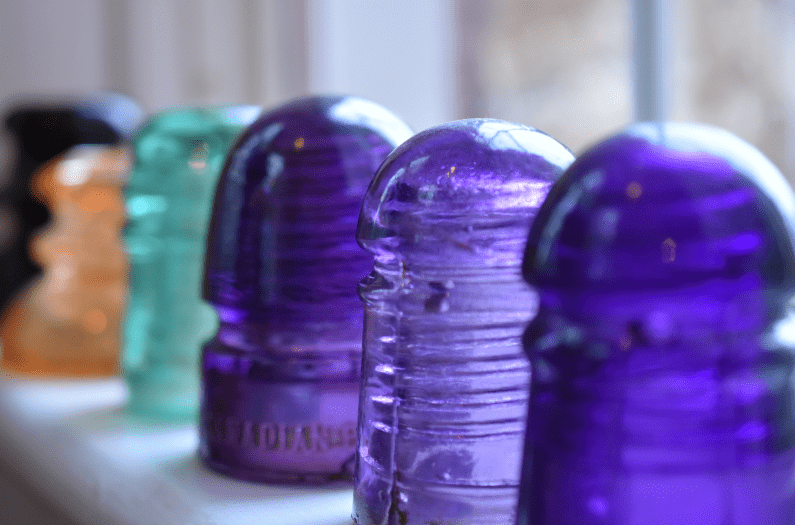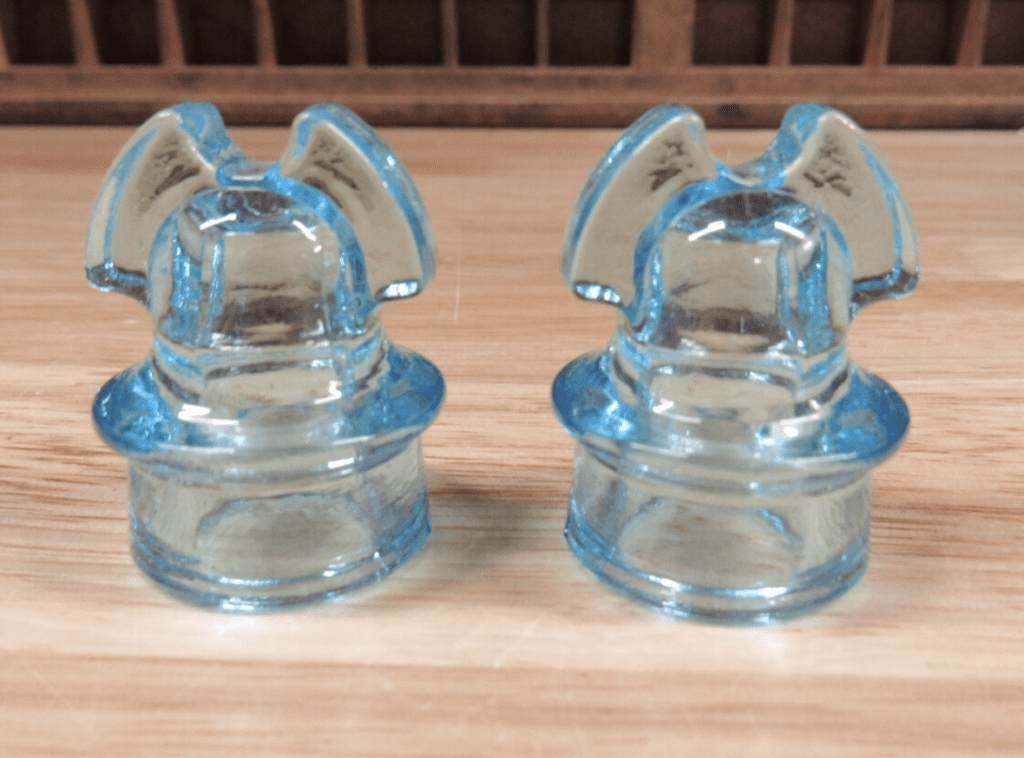What do cobalt, Mickey Mouse, and 7-Up have to do with each other? They can all be used to explain rare types of vintage glass insulators—styles and colors given relatable nicknames to encourage identification.
Vintage glass insulators’ uncommon types show up in hues of purple, cobalt blue, or several colors swirled together. They come in various styles, one of which is referred to as “Mickeys”. The most desirable pieces are a combination of uncommon styles & colors, or, sometimes, that rule is broken. For instance, if an uncommon style looks better in a common color or vice versa.
While possibly confounding upfront, it’s all quite explainable. Read on to find out about some of the rarest types of vintage glass insulators.

What are the rarest glass insulators?
The rarest glass insulators are generally either the oldest types or the ones with the fewest remaining examples. Ramshorn, block, and other early threadless types are all considered rare, with some insulator collections being focused solely on these initial renditions. Among the more common threaded styles, rarity can be based off style, manufacturer, color—really any of the aspects that determine an insulator’s value:
- The CD 100.2, of which only five to ten specimens are known, is considered rare for its specific style.
- By comparison, for the CD 150, a more common style, a Brookfield-manufactured specimen will garner only around $500. However, a CD 150 Barclay is worth around $5,000: ten times the amount because there are fewer pieces made by that particular manufacturer.
- Of course, desirability spins the market too. CD 141.9, with 20-25 known samples, is considered more desirable than CD 100.2 and can catch 2-3x the price despite being technically less rare.[1]
CD 141.9 only ranks sixth most desirable by a survey conducted on ICON[2] (a group of 2000+ insulator collectors) in 2013. At the top of the list, the Mickey Mouse (CD 257) & the Beehive (CD 145) were tied for first place. The Beehive is an aesthetically pleasing but fairly common type, while the Mickey Mouse is a less common find. The Mickey is unusual for its lack of skirt grooves, the wires instead secured under “ears” on top. An Electric Blue CD 257 (Mickey) can sell for over $1000; its counterparts in Aqua or Hemingray Blue only bring in $30.[3]

Mickeys hold up well to their task: they were originally patented in 1890. Over a century later, in 2001, a double-circuit line in Minnesota was found to be entirely insulated with aqua Mickeys, twelve to a pole.[4]
Why are Glass Insulators Different Dolors?
Sometimes different colors of insulators were purposefully made, other times it was just convenience. In signal insulators, made for railway signal circuits, different colors were factory-made in order to differentiate the different circuits easily.[5] Alternatively, sometimes the electrical companies setting up the circuits had design opinions. Western Electric insisted on clear glass for their insulators around 1930-31. Hemingray complied, although they achieved what is now known as “ice blue” rather than a true clear glass.[6] Carnival glass coatings & flashed amber were used purposefully for certain insulators as well.
On the other hand, some insulators were made from “end-of-day” glass or recycled bottle glass. These insulators are unusual colors or mixes of colors that make them stand out in a collection nowadays. End-of-day insulators were made with the leftovers of whatever project the glass house had been working on that day. Easy molds to fill, insulators were the ideal way to not waste glass. This resulted in cranberry glass pieces and insulators with swirls of different projects mixed together, among other combinations. Recycled bottles often created green to amber insulators with bubbles and swirls trapped in the glass.
What Colors do Glass Insulators Come In?
Glass insulators come in nearly the entire range of the rainbow—except red. Besides the practical aspect of the bright color functioning as a beacon for vandals, red was an incredibly difficult color of glass to manufacture through the early 20th century. It required gold chloride and extra careful control of temperature and humidity during the process.
There is only one record of red glass insulators in the US: 300-400 ordered from Ohio Brass for a municipal fire department. The glaze engineer purportedly threatened to horsewhip any O-B salesmen that accepted another order for red insulators.[7]
Far more common for insulators was the range from clear to aqua coloring. Of specific note here is the color known as Hemingray Blue.[8] Hemingray used this shade of deep blue through a large number of their insulators, before transitioning to primarily clear glass in the 1930s. Hemingray Blue isn’t exactly a rare color, but it is valued for its associated with this single insulator company.

The rest of the rainbow are rarer to find, existing in shades of purple, cobalt blue, olive, 7-up green, and amber. Amber and lavender glass have the potential to not be the original color of the insulator, which adds an interesting twist. Prior to the 1930s, clear glass could oxidize into these shades (depending on the chemical used). Sometimes they’ve been exposed to UV rays purposefully, while in other cases it’s a matter of long years exposed to the sun.
What are the Rarest Colors of Glass Insulators?
True purple—a deep shade of violet that was the initial glass color rather than UV-created—is a rarity to find. Cobalt blue, as well. These two have in common that they are deep shades, unusual to find because of the difficulty of coloring glass so intensely. They both attract quite a bit of attention in collector circles. Deep amber and olive green are similar situations.
Beyond shades of glass, there are certain types of glass with their own unique colorings that were only used for a few insulators each. Opalescent glass, Vaseline glass, & slag glass were all used, most likely during end-of-day clearing outs, to manufacture a small number of insulators. These are prizes to find today—if you like the odd pieces.
A vast array of vintage glass insulators existed: some style-color combinations were made in the millions (like an aqua CD-154), while others were just scrap-using handfuls. Each one fascinates with the history they’ve been part of, while the rare ones are, often times, especially spectacular to admire. Thanks to continuing interest in insulator collecting, these stunning pieces should be around to garner admiration for quite some time yet.
[1] https://www.beachcombingmagazine.com/blogs/news/glass-insulators-conducting-fascination-for-over-100-years
[2] https://www.insulators.info/icon/
[3] https://www.insulators.info/photos/photos/257-hemi-040-electric-blue.htm
[4] https://www.insulators.info/service/257pole.htm
[5] https://www.collectorsweekly.com/articles/an-interview-with-antique-glass-insulator-collector-ian-macky/
[6] https://www.insulators.info/articles/woodward/hemingrray-42.htm

